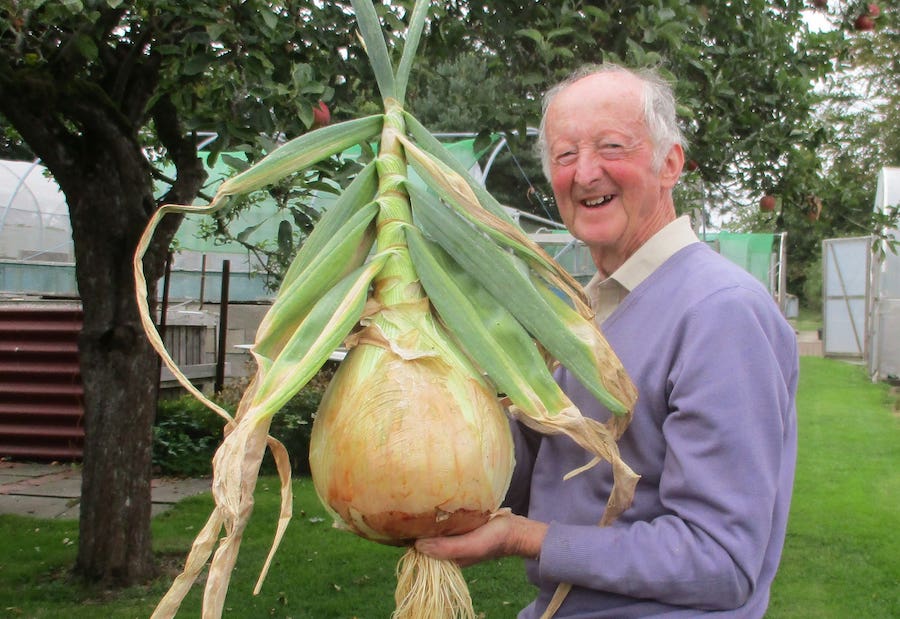Meet the man who grows the biggest vegetables in the world
Enormous onions and huge aubergines are a passion of record-breaking grower
In some aspects of life, size matters – and such is the case of champion giant-vegetable grower, Peter Glazebrook.
The Nottinghamshire gardener has spent more than 30 years growing gargantuan veg, from cauliflowers that you need a truck to transport, to melon-sized tomatoes, and holds the Guinness world record for heaviest potato (4.98kg/10lbs 14oz), heaviest cauliflower (27.48kg/60lbs 9.3oz) and heaviest aubergine (3.362kg/7lbs 6.6oz).
He held the record for the heaviest onion (8.2kg/18lbs 1.5oz) until a fellow grower beat him by 10oz, a few years ago.
View this post on Instagram
Glazebrook, 79, assisted by his wife, began by entering normal-sized veg at local shows and progressed from there. He has more than 17 records during his growing career.
Today, from his half-acre garden, he produces his show-worthy specimens, which he enters in the famous Canna UK National Giant Vegetables Championship at Malvern Autumn Show, where competitors enter a wealth of categories, from longest leek to heaviest luffa.
Glazebrook, a retired building surveyor, is entering almost all the classes – including cucumbers, aubergines and onions – in this year’s competition, apart from those which he finds too heavy to lift and transport, including pumpkins and marrows.

Growers bring their giant vegetables to be judged at the Canna UK National Giant Vegetables Championship
He doesn’t use automatic watering systems, preferring to rely on his own manual watering regime, using recycled rainwater from his roof. When he transports his veg to the show, he wraps most of them in damp towels to keep them fresh and stop them losing weight, as well as to protect the veg in transit.
“I’m hoping for a long runner bean this year,” he reveals. “The longest bean I’ve shown at Malvern is 35 inches – I’d like to beat that.”
How can you grow giant veg?
View this post on Instagram
“To start, you’ve got to ideally already be growing vegetables and ideally showing them at local level. If you find that you’re good at a particular vegetable and you want to grow it as a giant vegetable, that’s probably the way to go.”
How much space do you need?
“You need a large garden. Some people grow them on allotments but it’s never easy there.”
Which are the easiest to grow?
“The ones which grow in the summer, such as runner beans. They grow in the summer warmth and there’s not much requirement for heating and lighting or a (poly)tunnel.”
Seek out the right seeds
View this post on Instagram
“You must start with the right seeds, which you can get from other (giant veg) growers. Some seeds, such as kohlrabi are available as a commercial variety and you can buy them. For others, like cucumbers and onions, you have to have the right strain, which is basically in the hands of other growers.
“The best way is to go along to the shows, see what’s winning and talk to the growers there. I’m sure they’d be able to fix you up with the right seeds.”
Use social media, such as the Giant Vegetable Group on Facebook, to get in touch with growers for tips and seed recommendations, he suggests.
Give them the right conditions

The world’s heaviest field pumpkin grown by Mark Baggs
You need good ground, a greenhouse, protective tunnels, heating, lighting and all of the associated feeds, fertilisers and compost to have a chance of success, so you will have to invest some money if you’re serious about it, Glazebrook says.
“Stick to the basics, getting the NPK (nitrogen, phosphorus and potassium) and pH right. There are no restrictions on what you can give them to make them grow bigger.”
Sow seeds early
View this post on Instagram
“Larger onions, for example, need a long growing season. You’ve basically got to sow them before Christmas and go through the winter. I start mine off in a shed. With large onions, you can’t plant them out in the garden – you have to plant them in a greenhouse or in a tunnel as they need protection throughout.”
Are giant veg edible?
Some, like giant beetroot, are just too old and will be tough and woody, so you wouldn’t eat those. But tomatoes will be fine to eat, he suggests.
What do you do with the veg when the competition’s over?
View this post on Instagram
“To get the best seed, try to save your winning veg. With an onion, for instance, you can try and put it back to seed for the following year. Root it over the winter and it grows on next year, and produces a seedhead. If you collect the seed from that, the following year you can sow that seed.”
Cucumbers can be left to ripen for a few weeks before you cut them open and remove the seed for sowing the following year.
Check criteria
Entry regulations may differ from show to show. One show might stipulate, for instance, that an onion needs its roots cut off, while another might say they have to be left on. Read the schedule carefully to avoid disqualification.
Don’t go on holiday in the growing season
“We never go away because of the veg,” he admits. “Once we start at Christmas, we don’t go away until after the show.”
Malvern Autumn Show takes place at the Three Counties Showground, Malvern, Worcestershire, WR13 6NW, from September 23-25.
The Press Association
Latest posts by The Press Association (see all)
- BBC to air two-part Call The Midwife Christmas special - December 23, 2024
- 6 mind sports to exercise your brain and keep you sharp - December 20, 2024
- Quiz: What classic Christmas food or drink are you? - December 20, 2024
- Leftover turkey and watercress pie - December 20, 2024
- Catherine and William choose family shot for Christmas card photograph - December 19, 2024




















